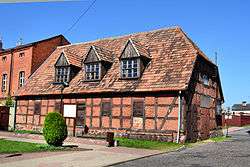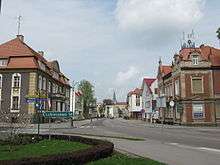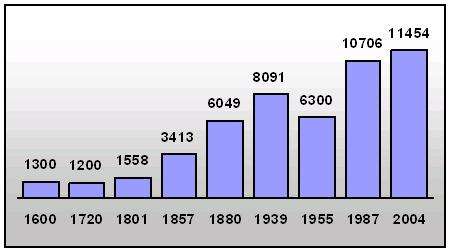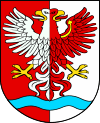Drawsko Pomorskie
| Drawsko Pomorskie | |||
|---|---|---|---|
  .jpg) | |||
| |||
 Drawsko Pomorskie | |||
| Coordinates: 53°32′N 15°48′E / 53.533°N 15.800°E | |||
| Country |
| ||
| Voivodeship | West Pomeranian | ||
| County | Drawsko | ||
| Gmina | Drawsko Pomorskie | ||
| Established | 7th century | ||
| Town rights | 1297 | ||
| Government | |||
| • Mayor | Zbigniew Ptak | ||
| Area | |||
| • Total | 22.24 km2 (8.59 sq mi) | ||
| Elevation | 160 m (520 ft) | ||
| Population (2013) | |||
| • Total | 11,878 | ||
| • Density | 530/km2 (1,400/sq mi) | ||
| Time zone | CET (UTC+1) | ||
| • Summer (DST) | CEST (UTC+2) | ||
| Postal code | 78-500 | ||
| Area code(s) | +48 94 | ||
| Car plates | ZDR | ||
| Website | http://www.drawsko.pl/ | ||
Drawsko Pomorskie [ˈdrafskɔ pɔˈmɔrskʲɛ] (German: Dramburg) is a town in Drawsko County in West Pomeranian Voivodeship in northwestern Poland, the administrative seat of Drawsko County and the urban-rural commune of Gmina Drawsko Pomorskie. As of 2013, the town has 11,878 inhabitants.
Geography
Located in the southeast of West Pomeranian Voivodeship (since 1999) in the Farther Pomerania region, Drawsko is situated within the Pomeranian Lakeland, the western spur of the Baltic Uplands. The town lies on the headwater of the Drawa River, a right tributary of the Noteć, west of an expansive woodland with the protected area of the Drawsko Landscape Park.
The regional capital Szczecin is about 100 km (62 mi) to the west. A large proving ground south of the town is frequently used in NATO exercises.
History
.jpg)
From the 7th century onwards Slavic tribes settled along the shores of the Drawa River, where they erected a fortress a few kilometers north of Lake Lubie. In the 10th century the region was under the sovereignty of the Piast duke Mieszko I of Poland; however, the sparsely inhabited border area during the fragmentation of Poland was also claimed by the Dukes of Pomerania, and later also by the mighty Ascanian margraves John I and Otto III, who in 1257 had founded the town of Landsberg (present-day Gorzów Wielkopolski) on the Noteć River as centre of their New March (Neumark) estates.
Neumark
At that time, the fortress of Drawsko had been held by Duke Przemysł I of Greater Poland, but after his death the settlement was also acquired by the Margraves of Brandenburg. They invited Premonstratensian monks from Belbuck (Białoboki) Abbey near Trzebiatów to found a monastery in their new territory. These plans failed, however, as the desired location was too far from Belbuck and the monks saw the wilderness as unsuitable. The Brandenburg margraves planned to expand upon a settlement already developing near the fortress of Drawsko. The Uckermark knights Arnold, Konrad and Johann von Goltz were granted the right to develop the settlement into a town mentioned as Drawenborch. It grew after the arrival of German colonists, allowing the margraves to grant it Magdeburg city rights in 1297.
When the Ascanian dynasty became extinct in 1320, the colonisation efforts in the Neumark region abated. Nevertheless, to promote the further development of the newly established town of Dramburg, the Wittelsbach margrave Louis I of Brandenburg released the town from all duties from 1338 until 1350, when he ceded the town as a fief to the noble Wedell family. On 13 February 1368, Dramburg was the setting of a peace treaty between Elector Otto VII of Brandenburg and King Casimir III of Poland, whereby Otto ceded the town of Wałcz to Poland. The influx of colonists began to cease, although by the end of the 14th century the Dramburg Neustadt ("new town") had developed on the southern shore of the Drawa.
The decay of the Neumark continued under the House of Luxembourg: held by Jobst of Moravia since 1388, it was pawned by his cousin Sigismund (the later Holy Roman Emperor) to the Teutonic Knights in 1402, who also neglected the region, which furthermore was devastated by Hussite forces in 1433. In 1454 the Knights returned the Neumark to the Hohenzollern elector Frederick II of Brandenburg. From that time on, the Hohenzollerns retained the region; the red eagle of the town's coat of arms was taken from the coat of arms of Brandenburg.[1]
In 1537 the former Franciscan monk Faustinus Schliepe introduced Lutheranism to Dramburg during the Protestant Reformation. From 1540 the town was administered by the Order of St. John in Germany (until 1808). A great fire destroyed a wide section of Dramburg in 1620, leaving only five houses unscathed, while five years later numerous citizens died from plague. In 1638 during the Thirty Years' War, the Swedish colonel Beer plundered and pillaged Dramburg. Despite that setback, the town's economic advantages allowed it to recuperate quickly. Dramburg had staple rights, giving it the privilege to force merchants traveling on the Drawa to offer their wares, such as Kolberg salt, for sale at Dramburg's markets. Wool-weaving and shoe-making were also important craft industries since the Middle Ages.
Province of Pomerania

Dramburg became part of the Kingdom of Prussia in 1701. With the reorganization of the Prussian provinces in 1815 following the Napoleonic Wars, Dramburg left the Neumark region and in 1818 became the seat of Landkreis Dramburg in the Regierungsbezirk of Köslin within the Prussian Province of Pomerania. Dramburg joined the German Empire in the 1871 unification of Germany.
In 1877 the Pommersche Zentralbahn (Pomeranian Central Railway) became connected to the town, which was also connected in 1896 to the Saatziger Kleinbahnnetz (Saatzig District railroad network). Dramburg's access to the railroads led to the establishment of wood and textile industries. This led the Pommersche Saatzucht Gesellschaft based in Stettin to use the Dramburg region as a testing area for its plant breeding experiments.
After parts of the eastern German Empire were granted to the Second Polish Republic following the 1919 Treaty of Versailles after World War I, many Germans from the former Province of Posen immigrated to Dramburg, expanding settlement in the south of the town. When the province of Posen-West Prussia was disbanded in 1938, Dramburg became part of Regierungsbezirk Schneidemühl. During World War II, the SS established a large training school for motorcyclists and mechanics in Dramburg.
Poland
In the course of the Vistula–Oder Offensive, on 4 March 1945 Red Army and Polish troops captured the city, whose center was largely destroyed during the fighting. Polish authorities began administering the town on 6 March 1945. The town was granted to the Republic of Poland according to the Potsdam Agreement and the remaining German citizens were expelled.
The town, renamed Drawsko Pomorskie in 1950, was the administrative seat of a powiat until 1975. After the Local Government Reorganization Act of 1998, Drawsko became a district seat again in 1999.
Population

Notable people
- Hans Wolter (1911–1978), physicist
- Mariusz Rumak (born 1977), football manager
International relations

Twin towns — Sister cities
Drawsko Pomorskie is twinned with:
References
External links
| Wikimedia Commons has media related to Drawsko Pomorskie. |
- Municipal website (Polish)
- Portal of Drawsko Pomorskie (Polish)
- Portal (Polish)
- Heimatgruppe Dramburg in Pommern (German)
- Dramburg on historical map of Pomerania
- Jewish Community in Drawsko Pomorskie on Virtual Shtetl
Coordinates: 53°32′N 15°48′E / 53.533°N 15.800°E


